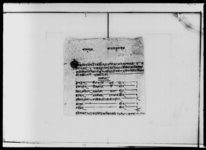A receipt for the ṭīkābheṭ levy offered to the generals of Thāpāthalī (VS 1918)
ID: E_2778_0047
Edited and
translated by Astrid Zotter
Created: 2018-06-18;
Last modified: 2018-11-26
For the metadata of the document, click here
The accompanying edition, translation/synopsis and/or commentary are available under the terms of the Creative Commons Attribution-ShareAlike 4.0 International License
Abstract
This document acknowledges the receipt of 15 rupees as ṭīkābheṭ offered on the occasion of Baḍādasaĩ by the officers of the Jagaddala Palṭana to the six generals of Thāpāthalī.Diplomatic edition
[1r]
[?]1श्रीजगद्दल•2२1श्रीजनरलसाहेव•
2१[unknown seal]1[?]र्पाईदादै•श्रीलेफ्टेंटकर्णैल्लालसिंषतृआगे•थापाथली ¯ ¯१¯ ¯ हरू
2जना६लाई• ¯ ¯२¯पल्टन्कापगरीहरूलेवडादसैंकोठीकाभेट्चर्हा
3याकोमोहररूपैयापंध्र•१५वहीदारहंसवीरहस्तेमसँगदाषिलभ
4यो•तस्कोभर्पा इलेषीदिञाँ¯¯¯¯¯¯
[table1]
| 1 | लेफ्टेन् | गंभीरसिंगुरूं | कोरू | १ |
| 2 | इन्सायेन् | शिवलालऐं | कोरू | १ |
| 3 | मेजरअजिटन् | दलभंजनथापा | कोरू | १ |
| 4 | षरीदार | लक्ष्मीभक्तउपाध्याय• | कोरू | १ |
| 5 | सुवेदारजना१०मध्येषाली१वाकी९ | कोरू• | ९ | |
| 6 | कोत्या• | को•रू | १ | |
| 7 | राईटर• | कोरू | १ | |
| 8 | १५ | |||
5इतिसम्वत्१९१८सालमितिआश्वीनसुदि१४रोज५शुभम•¯ ¯ ¯
Translation
[1r]
Venerable Jagaddala – 2
Venerable General Sāhebas – 1
Receipt (bharpāīdādai); [issued to] venerable Lieutenant Colonel Lāla Siṃ Khatṛ.
Āge: Fifteen, [in numbers] 15, mohararūpaiyā̃s offered as the Baḍādasaĩṭīkābheṭ by the officers (pagarī) of the [venerable Jagaddala]1 Palṭan to the 6 [General Sāhebas]2 of Thāpāthalī, was delivered into the hands of3 BahīdāraHaṃsavīra. He issued a receipt for it.
[table]
| Lieutenant Colonel | Gaṃbhīra Siṃ Gurūṃ | Rs | 1 | |
| Ensign | Śiva Lāla Gurūṃ | Rs | 1 | |
| Adjutant Major | Dalabhaṃjana Thāpā | Rs | 1 | |
| Kharidāra | Lakṣmībhakta Upādhyāya | Rs | 1 | |
| 9 subedāras; of 10 only one remaining | Rs | 9 | ||
| The kote | Rs | 1 | ||
| The raīṭara | Rs | 1 | ||
| 15 |
Thursday, the 14th of the bright fortnight of the month of Āśvina in the [Vikrama] era year 1918 (1861 CE). Auspiciousness.
Commentary
The document concerns the submission of the ṭīkābheṭ (or ṭīkābheṭī), a levy that was to be paid on the occasion of the autumnal Dasaĩ festival by military and civil officials to the central authority (cf. Regmi 1983; Zotter 2018: 508, referring to NGMPP DNA 2/81, lines 13–18). The typical sum of 1 Rs per head is mentioned both here and in other documents (cf. DNA_0002_0020; DNA_0004_0084; Regmi 1971: 192; Regmi 1984: 132). At the beginning of the 20th century the rate seems to have increased. Thus Regmi (1983: 14) quotes an arrangement valid from 1929 onwards with rates of Rs 16 for the commander-in-chief, 12 Rs for high officers, and 3 Rs for others. These sums went to the reigning king, his queens, the queen mothers (i.e. legitimate wives of the king's father), and princes and princesses according to a fixed scheme (ibid.: 12–13). Interestingly, the present document, pertaining to the levy paid by officers of an army unit, stipulates the Thāpāthāli generals—that is, the heads of the Rāṇā family who were in command of the army—as receivers of the levy, not the royal family.
The names of other high officers mentioned in the text reveals their ethnic background as being Gurung (the lieutenant colonel and the ensign) and probably Magar (the Thāpā adjutant major), while the hierarchically lower-ranking post of secretary (kharidāra) was occupied by a Brahmin of Upādhyāya status. Such hierarchical schemes must have been a new phenomenon at that time. Previously officer ranks (called pagarī, denoting the ranks from subedāra on up; see Whelpton 1991: 239 n. 103) were reserved for members of the Indo-Nepalese upper castes (Thakuri, Khas and Brahmin), while Magar and Gurung could serve in the lower ranks only (ibid.: 208–210). This development seems to have been connected with the creation of new military posts. According to Hamal (1995: 32) the posts of general and colonel were added under Bhīmasena Thāpā with a general being in command of the kampus stationed in Kathmandu and the colonels commanding the forces outside the Valley. Whelpton (1991: 210), dealing with Jaṅga Bahādura's recruitment strategy for the army, pins down the opening up of the rank of colonel to Magars and Gurungs to a lālamohara issued in 1863 (ibid.: 210). The creation of the rank of lieutenant colonel, immediately below a colonel (cf. Adhikari 1984: 161 table VII), had been a recent introduction under Jaṅga Bahādura (Whelpton 1991: 208). As the present document shows, Gurungs could rise to that rank already in 1861.
The palṭana named in the document, Jagaddala, could be the "Jagdal" regiment, which is known to have existed around this time. Hamal (1995: 44) lists it among those formed between 1847 and 1881 but later dissolved. Adhikari (1984: 156 table IV) places it among regiments existing in 1863. Regmi (1979: 83) puts the "Jagadal Paltan" among the units forming the "Rajadal Kampu" in 1910. If this Jagdal or Jagadal is indeed identical with the present document’s Jagaddala, it must therefore have been raised between 1847 and 1861 and must have existed at least until 1910.

